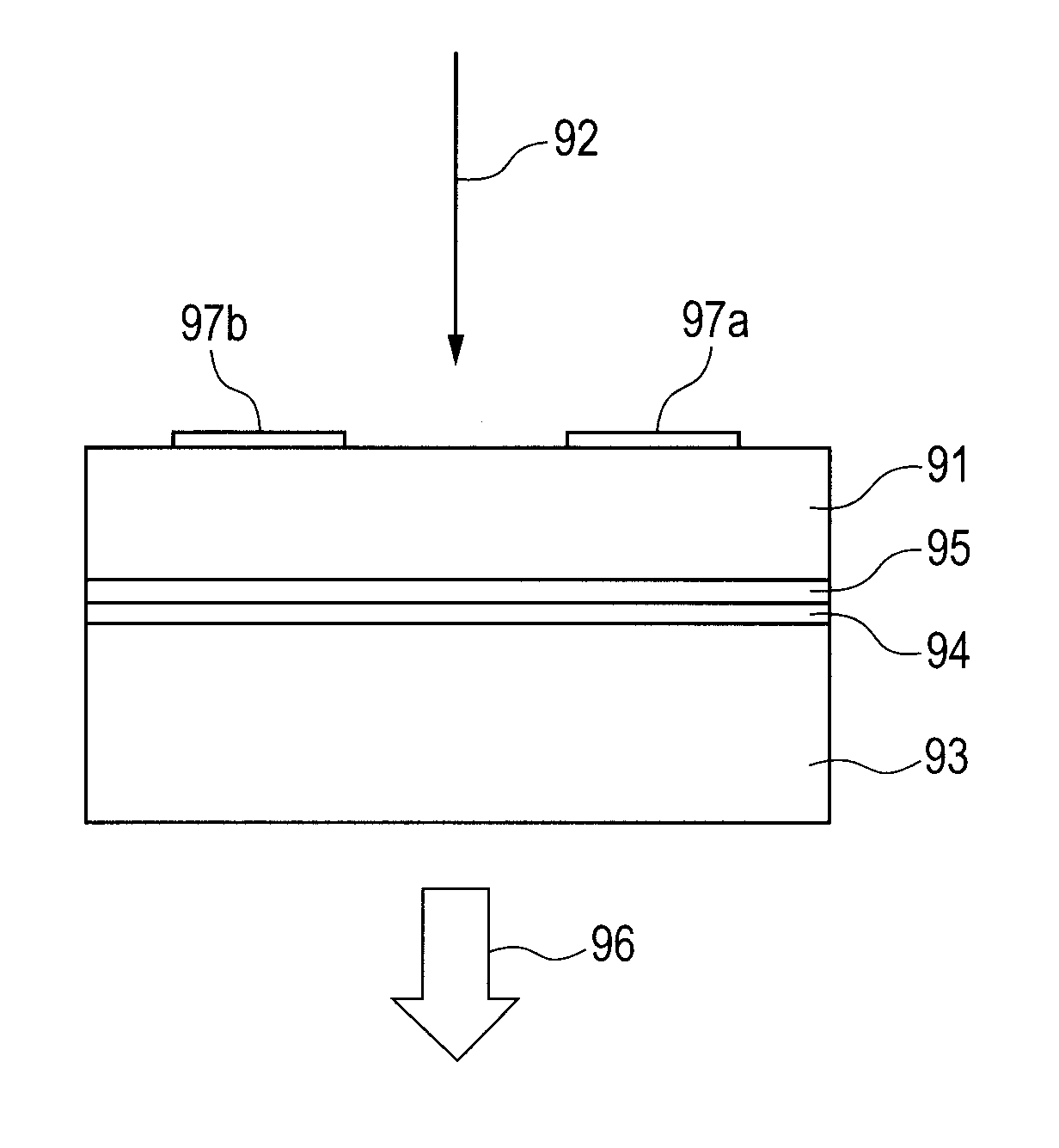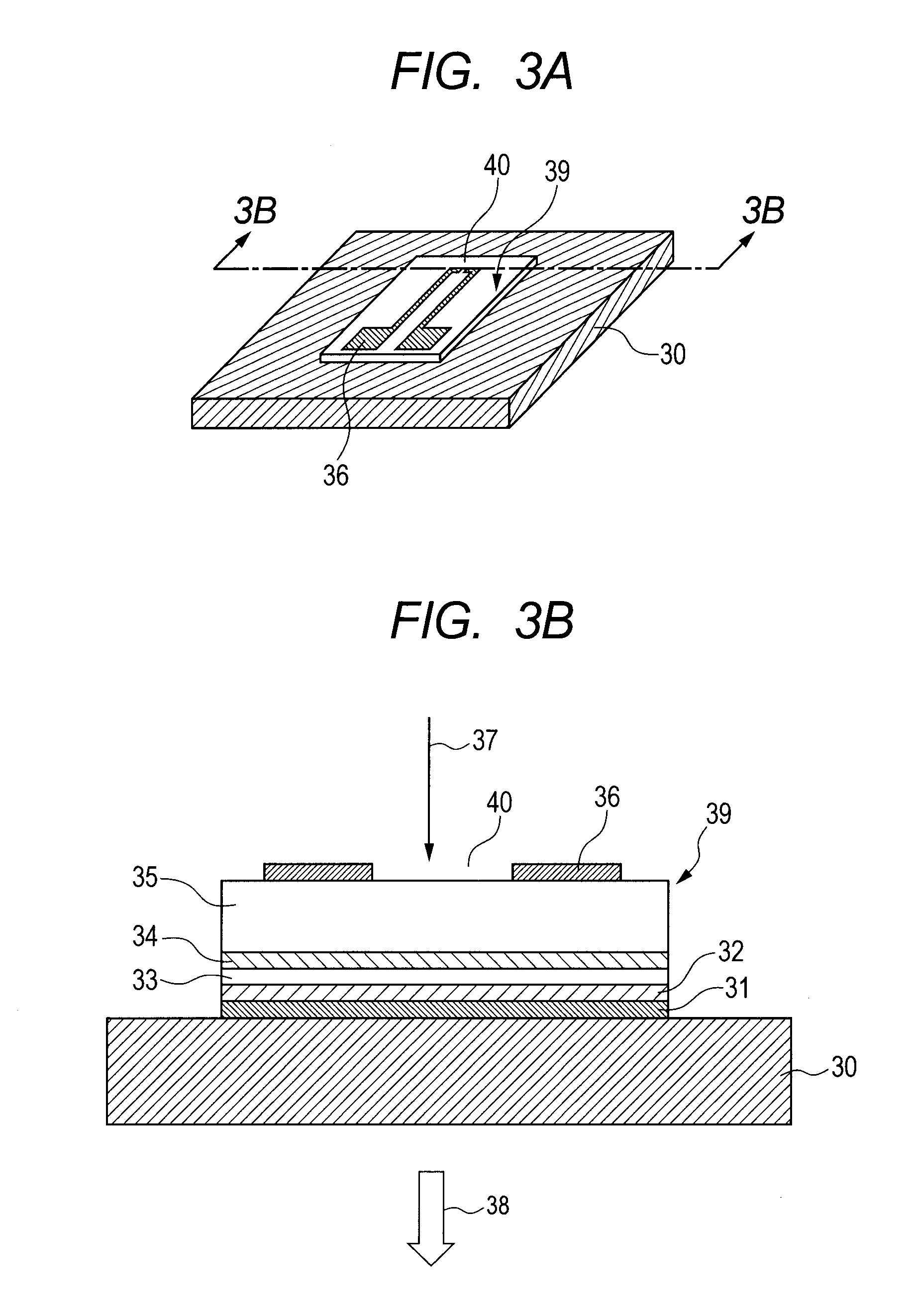Photoconductive element
a photoconductive element and conductive technology, applied in the field of photoconductive elements, can solve the problems of difficult to increase resistance, increase the number of crystal defects, and inability to increase the application voltage, so as to improve the terahertz wave generation efficiency as well as the s/n
- Summary
- Abstract
- Description
- Claims
- Application Information
AI Technical Summary
Benefits of technology
Problems solved by technology
Method used
Image
Examples
first embodiment
[0024]Referring to FIG. 1, a first embodiment of the present invention is described. In this embodiment, an InGaAs layer 11, an InAlAs layer 12, and an InGaAs layer 13 are formed on a semi-insulating InP substrate 10 at a normal growth temperature, and an LT-InGaAs layer 14 is formed thereon by low temperature growth as a semiconductor low temperature growth layer. In order to function as a photoconductive element, a pair of electrodes 15a and 15b also serving as an antenna is formed on the surface.
[0025]The semiconductor low temperature growth layer 14 generates a terahertz wave 17 by irradiation of laser light 16. In order to operate with light at a wavelength of, for example, 1.55 μm and to increase the resistance, the semiconductor low temperature growth layer 14 is doped with Be at 1018 cm−3 and grown at a growth temperature of 200° C. and further annealed at about 600° C. to enhance the crystallinity. The growth temperature of the semiconductor low temperature growth layer is ...
example 1
[0032]In Example 1 of the first embodiment, a layer that lattice-matches with an InP substrate (lattice constant: about 0.587 nm) is used. From a practical viewpoint of the element, a lattice-matched layer as used herein refers to a layer whose thickness does not exceed a critical thickness even if grown to be about several hundreds of nm or more in thickness, specifically, a layer which has the degree of lattice mismatch of 0.1% or less (see, for example, H. Komatsu ed., Handbook of Crystal Growth, Kyoritsu Shuppan, p. 699, 1995), and a lattice-mismatched layer refers to a layer which has a larger degree of lattice mismatch than 0.1%. In view of the above, the InGaAs layer 11, the InAlAs layer 12, and the InGaAs layer 13 were set to have In compositions of 0.53, 0.52, and 0.53 and thicknesses of 270 nm, 20 nm, and 5 nm, respectively. The semiconductor low temperature growth layer 14 was set to have an In composition of 0.53 and a thickness of 1.6 μm.
[0033]An example of configuring ...
example 2
[0037]Example 2 of the first embodiment is described. In this example, in order to more improve the resistivity, the In composition of the semiconductor low temperature growth layer 14 was set to 0.45. Although the band gap wavelength is 1.49 μm, since an electric field is applied for the function as a generating element, actually, laser light in the vicinity of 1.55 μm can also be absorbed.
[0038]In this case, the InGaAs layer 11 was set to have a total thickness of 270 nm, in which the thickness of a lattice-matched layer having an In composition of 0.53 was 250 nm and the thickness of a graded layer for reducing the In composition from 0.53 to 0.45 was 20 nm. The InAlAs layer 12 was 20 nm thick having an In composition of 0.45 (lattice constant: 0.584 nm). The InGaAs layer 13 was 5 nm thick having an In composition of 0.45 (lattice constant: 0.584 nm). Note that, the lattice constant values were determined according to the Vegard's law. In this case, the degree of lattice mismatch...
PUM
| Property | Measurement | Unit |
|---|---|---|
| temperature | aaaaa | aaaaa |
| temperature | aaaaa | aaaaa |
| telecommunication wavelength | aaaaa | aaaaa |
Abstract
Description
Claims
Application Information
 Login to View More
Login to View More - R&D
- Intellectual Property
- Life Sciences
- Materials
- Tech Scout
- Unparalleled Data Quality
- Higher Quality Content
- 60% Fewer Hallucinations
Browse by: Latest US Patents, China's latest patents, Technical Efficacy Thesaurus, Application Domain, Technology Topic, Popular Technical Reports.
© 2025 PatSnap. All rights reserved.Legal|Privacy policy|Modern Slavery Act Transparency Statement|Sitemap|About US| Contact US: help@patsnap.com



